Tell Arbid (Syria)
Fifteenth Season of Syrian–Polish Archeological Excavations on Tell Arbid
Dates: 21 August – September 29, 2010
Team:
Prof. Dr. Piotr Bieliński, director (Institute of Archaeology, University of Warsaw)
Dr. Abed Abdel Mesih Bagdo, director (Regional Department of Antiquities in Hassake)
Dr. Agnieszka Pieńkowska, archaeologist (PCMA)
Dr. Łukasz Rutkowski, archaeologist (PCMA)
Dr. Arkadiusz Sołtysiak, anthropologist (Institute of Archaeology, University of Warsaw)
Dr. Anna Smogorzewska, archaeologist (Institute of Archaeology, University of Warsaw)
Dr. Dariusz Szeląg, archaeologist (Institute of Archaeology, University of Warsaw)
Dorota Bielińska, archaeologist (Polish Academy of Sciences)
Shiar Halaf, topographer (Regional Department of Antiquities in Hassake)
Rashad Kusa, archaeologist (Regional Department of Antiquities in Hassake)
Marta Momot, documentalist (PCMA)
Mattia Raccidi, archaeologist (University of Naples)
Andrzej Reiche, archaeologist, photographer (National Museum in Warsaw)
Jovan Qassem, archaeologist (Regional Department of Antiquities in Hassake)
Agnieszka Szymczak, archaeologist (PCMA)
Simon Yacoub, archaeologist (freelance)
Students of archaeology: Cezary Baka, Ewa Czyńska, Jacek Hamburg, Krzysztof Kiersnowski, Dominika Kossowska, Katarzyna Pawłowska (University of Warsaw)
This year’s work centered around the Southern Temple — a Ninevite 5 period sanctuary discovered in 2007 in Sector W-East, on the southern slope of the tell — and on a massive mud-brick wall stretching east of the temple and probably dating from the Early Dynastic III period (see Tell Arbid in PCMA Newsletters 2007, 2008, and 2009).
Looking up to the Southern Temple: a stepped terrace and mud-brick ramp
Up till now it seemed that the temple was standing on a platform, which was discovered under the temple’s southern, front wall. Approximately 45 cubic meters of earth had to be removed this year before this feature could be investigated.
Three steps of the terrace (as the platform is now referred to) ranging in depth from about 2.00 to 2.60 m, were revealed this year. The top and middle step were about one meter high. The third, lowest step has not been cleared completely and it remains to be seen whether it is the bottommost step. Its surface is strongly inclined, so it seems to form a kind of glacis. Altogether the structure rises to a height of over 3.50 m. The known width is 7 m, although the side limits of the structure have not been reached as yet.
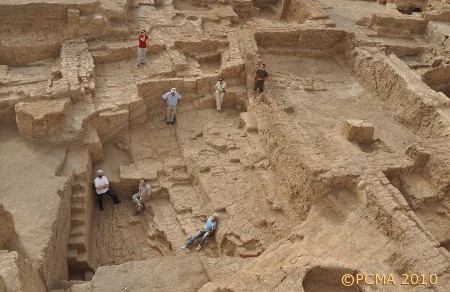
Architecture contemporaneous with the temple, discovered on all the other sides of the structure (see below), has made it clear that the steps did not continue all around. Thus it seems that the idea was to create an impressive visual approach: a high hill with a sanctuary at the top, towering over whatever was in front of it (an open space being the most probable, but still unchecked, possibility). It is the first known Ninevite 5 period temple accompanied by such a terrace. The role this structure may have played in the cult celebrated in the shrine remains unknown.
Impressive as it was, the terrace was quite inaccessible; the meter-high steps were hardly fit for priests or believers to climb. Remnants of a well-made mud-brick pavement, found this year west of the temple doorway, could have provided access to the shrine. This tentative ramp is about 2.25 m wide and slopes to the south. The inclination, measured on a stretch of pavement just 6 m long, was approximately 12 degrees. A reconstruction of its course, assuming these parameters, indicates that it could not have led to the phase of the temple that is currently exposed, but rather to a later, unpreserved stage of the structure.
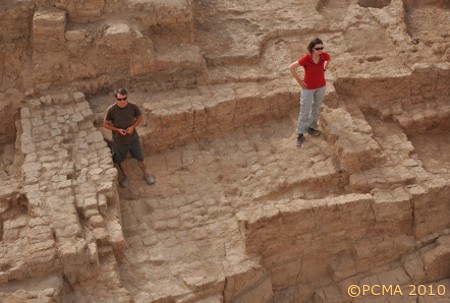
Unlike the terrace, the ramp had disappeared from view by the Late Ninevite 5 period, having been built over with a succession of three or four cubicles erected against a substantial wall aligned N-S, starting just west of the temple doorway. The entrances to the cubicles must have been in the western, as yet unexcavated part. The rooms continued in use until the beginning of the Early Dynastic III period. At this time a child burial was made in a mud-brick box under the floor of one of these cubicles.
Lights and shadows inside the Temple
Extra documentation work inside the Southern Temple yielded unexpected results. The cleaning of a partition wall separating the main cella from a kind of sacristy in the western part of the building revealed a row of plastered recesses on its eastern face (opposite the cella). The original three deep niches were later replaced with a series of smaller and shallower ones, and these in turn were filled and the wall face smoothed with plaster.
Testing east of the altar in the cella reached 2 m beneath the topmost floor of the sanctuary. Three main floor levels were identified some 0.20 m apart. The east wall of the temple was found to continue all the way down. Surprisingly, the plaster coating already beneath the level of the lowest of these floors was of superior quality compared to that on the walls of the currently exposed cella. It seems logical to assume that this wall belonged to an earlier shrine.
Kitchen, kiln and another sanctuary?
Enlarging last year’s trench west of the Southern Temple brought evidence of a single-room building adjacent to the sanctuary. Unfortunately, the interior of the room (which measures approx. 4.80 x 2.40 m with walls up to 1.20 m wide) was damaged by several large, intersecting pits of Khabour-period date. Another pit destroyed a stretch of the south wall of the room which must have held the entrance. Although almost nothing can be said of the room’s furnishings, a fragment of a small column(?) was found in one of the pits. It was made of unbaked clay and greatly resembled the incense burner discovered inside the Southern Temple in 2007. Based on these similarities, this structure has been interpreted tentatively as another sanctuary and dubbed the Southwestern Temple. The scant ceramic assemblage found in the remaining parts of the room shows that it was in use during the Late Ninevite 5 period.
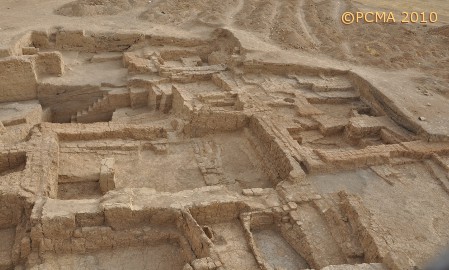
Excavations to the north of the Southern Temple were continued in two small rooms discovered in 2008. The better preserved one of the two contained several domestic installations, including two fireplaces, a mud-brick bin and some complete vessels, mostly of the cooking ware variety. Both rooms must have been part of a larger Ninevite 5 period structure abutting the north wall of the Southern Temple.
A large kiln was explored further to the northeast of the Southern Temple. The chamber measured approximately 2.30 m across and demonstrated no evidence of either open fire or any substances that could attest to the nature of its use. Perishable goods, perhaps grain, could have been processed in it. The ashy fill of the locus (probably a courtyard) where the kiln was located yielded 48 clay sealings, 36 of which bore seal impressions. More finds of the kind — 57 and of these 47 were impressed — came from the exploration and cleaning of an ash-filled locus northwest of the kiln, which now seems to have been part of the same L-shaped courtyard housing the kiln rather than a separate room.
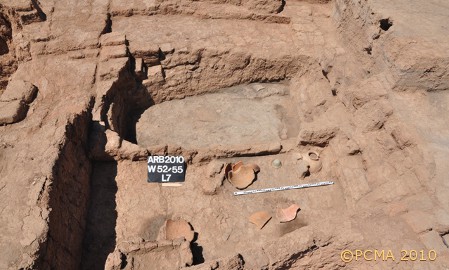
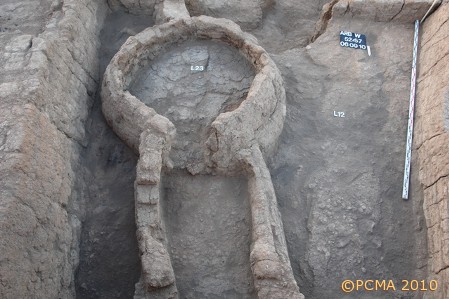
The elusive Big Wall
At the end of the previous season the structure dubbed the “Big Wall” was 16 m long and promisingly disappeared into the eastern trench wall, just under the surface (see Tell Arbid in the PCMA Newsletter 2009). Testing to trace the further course of this wall has largely failed, uncovering only a fragment some 3 m to the northeast of the point where it was visible last year. It formed a corner with a wall running northwest, which was uncovered in the very corner of the trench and is hidden in the north trench wall. Both walls suffered damage at the northeastern end, making it impossible to tell at this point, if the “Big Wall” had originally continued to the northeast. Excavations in trenches to the north and uphill from the wall have not reached a depth that could bring a conclusive answer.
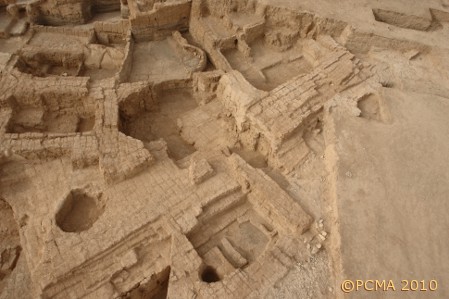
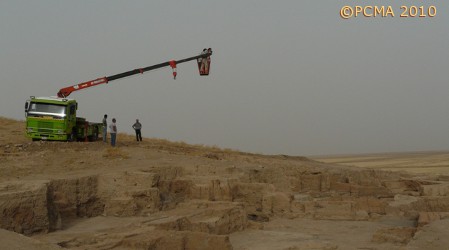
A grave, footprints and tokens
The test pits, although useless in the search for the “Big Wall”, proved worthwhile for the smaller finds they turned up. A not-so-small discovery was a Khabour-Ware-period grave (2.70 x 1.40 m) oriented NW–SE, with a burial shaft and entrance on the southeast. The roof of the chamber consisted of three rows of “diamond” bricks (that is, bricks set up on one corner), damaged in the southeastern part, probably by grave plundering in the past. The grave has not been explored this season.
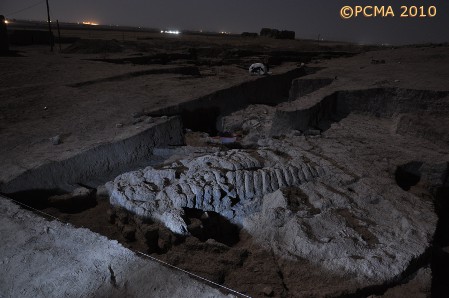
A unique set of 55 objects of unbaked clay came from a layer west of the grave, disturbed by digging during the Khabour Ware period. Apart from tokens of various shapes and sizes, there were also flat “mud-cakes” lying on large potsherds, 15 clay “spools” and many other objects, six of them decorated with an identical motif: two crossing lines and a dot in the center and in each of the quarters between the lines. The large potsherds probably came from a ceramic pavement just west of where the tokens were found.
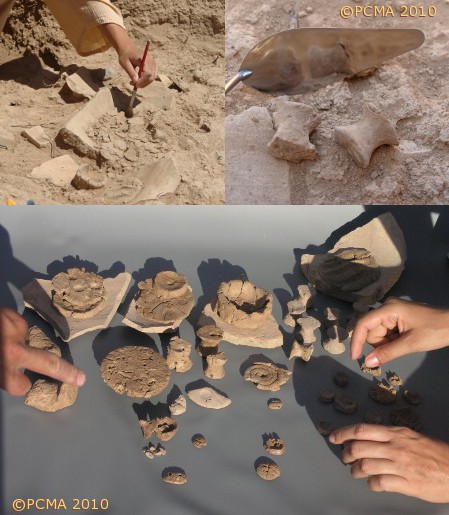
Another exceptional feature was located west of the pavement. It was a quadrangle of gray clay impressed when wet with human footprints (two indistinct heel impressions), hoof impressions of a sheep and donkey(?), and numerous streaks and sets of lines intentionally traced by hand. The impressed surface was discovered within the limits of a narrow trench, hence the broader context of this find has yet to be investigated. It is evident, however, that the quadrangle was bordered on two sides by mud-brick walls.
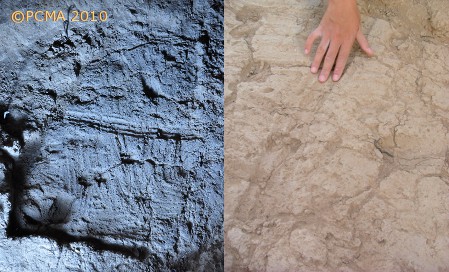
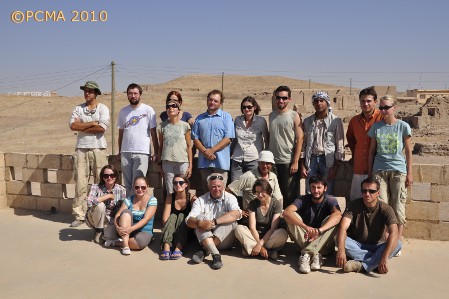
[Text:A. Szymczak based on official report by P. Bieliński]

